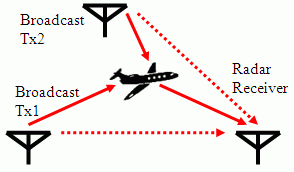Passive Bistatic Radar Based on Digital Broadcasts
Project Leader: Chris Coleman (UoA)
Project Team: Chris Baker (ANU), Yik Ling Lim (UoA), Heath Yardley (UoA), Robert Watson (UoB), Marco Martorella (UoP)
Funding: Self funded
Project background
Digital broadcasts have provided an ideal opportunity for passive bistatic radar (PBR), radar that is based on illuminations by transmitters of opportunity. Digital broadcast transmitters provide a fairly dense network of illuminators with high power and signals with nearly ideal ambiguity function. The University of Adelaide, in conjunction with the University of Bath, have developed a flexible PBR testbed that is based on advanced digital receiver technology. This system has been successful in detecting aircraft targets that are illuminated by the DAB (Digital Audio Broadcasting) system in the UK and is being further developed to detect such targets when illuminated by DVB (Digital Video Broadcasting). In 2010, an equivalent system was built in Adelaide to make use of the digital broadcasting that has started in Australia. The current thrust of this work is directed towards networked PBR in order to provide improved location and continuous radar coverage of large areas.
Project aim
The project will:
- Develop a network of PBR receivers in the Adelaide area in order to investigate the potential of PBR for air surveillance
- Develop technology for low cost and portable PBR receivers
- Develop detection and tracking algorithms for networked PBR
- Investigate the potential of PBR to augment current air surveillance systems

